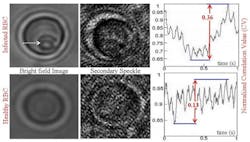Microscopy technique could detect malaria in a half-hour's time
Rapid detection of malaria—especially in remote areas of the world—is not always possible because current methods are slow and require precise instrumentation and highly skilled microscopic analysis. So, researchers at the Materials Technology Institute of the National Research Council (Trieste, Italy), led by Dan Cojoc, Ph.D., have developed a microscopy system that could diagnose malaria much faster and with greater accuracy.
The microscopy system uses "speckle imaging," an optical sensing technique that measures the differences in how laser light bounces off the membranes of healthy and infected red blood cells. By comparing the apparently random scattering (speckling) of light as it builds up from multiple images, a clear statistical pattern emerges that identifies cells that harbor the parasite responsible for malaria.
The microscopy technique the researchers used is called secondary speckle sensing microscopy (S3M). By applying it to an automated high-throughput system, the researchers were able to deliver results in as little as 30 minutes, with a high rate of accuracy, and without the need for highly trained technicians and a well-equipped hospital laboratory. The current time to diagnosis in most African medical centers is typically between 8 and 10 hours.
Secondary speckle sensing microscopy begins with illuminating red blood cells with a tilted laser beam. This produces a time-varied speckle pattern field based on the cells' thermal vibration and the movement of their membranes—traits that differ in healthy and diseased states. The speckle patterns are inspected under the microscope and recorded on a camera at a high frame rate. Using two automated analytical methods—"fuzzy logic" and "principal component analysis"—scientists scour a set of speckle parameters to extract statistical information about changes in red blood cells' membranes and their flickering movements. Scientists then make a diagnosis based on statistical correlations in speckle patterns between healthy and diseased cells.
According to the researchers, timely diagnosis maximizes the likelihood of successful, life-saving treatment. It also minimizes the chances that inappropriate therapy will be given, which would help combat the growing problem of drug-resistant malaria. And while the preliminary results of their study are encouraging, further study is needed to validate the results and further refine S3M, they say. If the positive outcomes hold up, field studies or clinical trials of S3M might be deployed as early as 2013.
The work has been published in Biomedical Optics Express; for more information, please visit http://www.opticsinfobase.org/boe/abstract.cfm?uri=boe-3-5-991.
